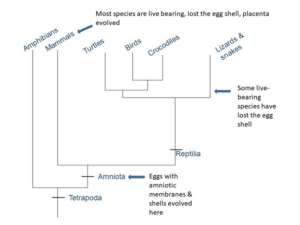Which came first—the chicken, or the egg?
OK, let’s settle this for once and for good! This question, that surely has been the basis of many family and social-hour squabbles, turns out to be extraordinarily simple to address. So, this will likely be my shortest Research Blog to date.
 Tetrapods are the group of animals with backbones that are not fish. In this sense, we might consider renaming ourselves as “Tetrapod Zoo of Atlanta” because these are the animals that drive our mission and command our attention and passion every day here at Zoo Atlanta. An amphibian eggs is like a little gelatinous aquarium in which the embryo develops until it, usually, becomes a free-swimming larva. However, the majority of tetrapods produce a more complicated egg that has multiple discrete membranous layers that serve different functions to protect the developing embryo. In most cases, the outermost layer is a calcium-based shell. Breakfast cooks know the shell intimately, and also the outermost membranous layer that directly underlies it—the one that vexes you when you didn’t quite crack the egg hard enough on the lip of the pan. This is the amniotic egg. Tetrapods that have this type of egg comprise the group Amniota, which really is all tetrapods except amphibians.
Tetrapods are the group of animals with backbones that are not fish. In this sense, we might consider renaming ourselves as “Tetrapod Zoo of Atlanta” because these are the animals that drive our mission and command our attention and passion every day here at Zoo Atlanta. An amphibian eggs is like a little gelatinous aquarium in which the embryo develops until it, usually, becomes a free-swimming larva. However, the majority of tetrapods produce a more complicated egg that has multiple discrete membranous layers that serve different functions to protect the developing embryo. In most cases, the outermost layer is a calcium-based shell. Breakfast cooks know the shell intimately, and also the outermost membranous layer that directly underlies it—the one that vexes you when you didn’t quite crack the egg hard enough on the lip of the pan. This is the amniotic egg. Tetrapods that have this type of egg comprise the group Amniota, which really is all tetrapods except amphibians.
At the risk of preaching to our choir of animal experts here, I’ll remind you that you already know all of this. You know that all turtles, birds, and crocodiles produce amniotic eggs. You know that a handful of mammals produce amniotic eggs. I’ll report to you here that tuataras have amniotic eggs and remind you know that you already know that the majority of snakes and lizards produce such eggs. The exceptions are the live-bearing species. However, these are not exceptions at all. Live-bearing snakes and lizards simply retain the egg after fertilization and it develops inside mom in exactly the same manner that it would in an underground nest. All of the amniotic membranes are present and the shell is simply not produced. The egg develops internally and is “laid” without a shell after which the youngster literally hatches out of these membranes moments after leaving the female’s body.
The mammals that do not produce shelled eggs are the placental mammals. But this really is just a minor twist on the amniotic egg. Like live-bearing snakes and lizards, placental mammals have all the same amniotic membranes. This is just a typical egg that is retained and develops internally. The twist here is that the membranes have become specialized to produce a unique structure we call the placenta. The placenta is a complex interface between the amniotic membranes and the maternal uterus that allows exchange of nutrients between mom and the embryo. But, at its core, it is just another internally developing amniotic egg.
So…………..which came first, the chicken or the egg?
The answer is deceptively simple. The amniotic egg showed up in the tetrapod Tree of Life far before birds existed. Of course this also means very much before chickens existed. So, the egg came way before the chicken—and way before birds even.
I hope this little lesson helps you win a few friendly debates, or even a bet! If you draw the tetrapod Tree of Life shown here on a scrap of paper or a napkin, while making your case, then be sure to know that you are making me very happy! We are looking forward to seeing you all this hopefully normal summer at the Zoo.
Joe Mendelson, PhD
Director of Research

Connect With Your Wild Side #onlyzooatl